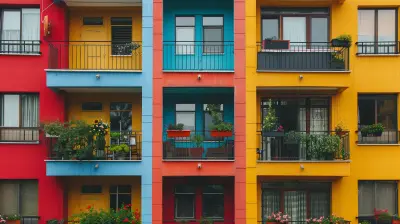Understanding Supply and Demand in Housing Markets
18 May 2025
The housing market—oh, what a wild and unpredictable beast! Some days, it roars with skyrocketing prices, leaving buyers gasping for air. Other times, it slumbers, with sellers scratching their heads, wondering when a buyer will finally bite.
But what truly drives this ever-changing landscape? It all boils down to two fundamental forces: supply and demand. These invisible hands shape everything, dictating home prices, inventory levels, and whether you're stepping into a buyer’s paradise or a seller’s dream.
Let’s unravel this mystery, shall we? 
The Magic Behind Supply and Demand
At its core, the housing market follows the same golden rule as any other market—when demand exceeds supply, prices soar. When supply outpaces demand, prices tumble. Sounds simple, right? Well, not so fast.Real estate isn’t like selling apples at a farmers’ market. Houses take time to build, neighborhoods evolve, and economic factors can shift overnight. Whether you're buying, selling, or just curious, understanding these forces can help you navigate the stormy waters of real estate.
So, let’s break it down. 
What Drives Housing Demand?
Demand, my friend, is a fickle thing. It can skyrocket overnight or come crashing down in a heartbeat. Here are some of the biggest players pushing demand up or pulling it down:1. Interest Rates: The Puppet Master of Demand
Mortgage rates can make or break a buyer’s decision. When interest rates are low, borrowing money is cheaper, and more people jump into the housing market. But when rates climb? Buyers step back, reconsider, or wait for better days.2. Population Growth: The Fuel to the Fire
More people mean more demand. Cities with booming populations—thanks to job opportunities, lifestyle appeal, or migration—often see intense housing demand, leading to higher prices and competitive markets.3. Employment and Income Levels
Let’s be real—if people don’t have stable jobs or rising incomes, they’re not buying houses. When the economy is thriving, confidence soars, and more buyers flood the market. But during recessions? Not so much.4. Government Policies & Incentives
First-time homebuyer credits, tax breaks, and lower lending standards can all fuel demand, pushing more people toward homeownership. On the flip side, stricter lending policies can cool things down quickly.5. Consumer Confidence: The Vibes Matter
If people believe home values will rise, they rush to buy before prices climb further. But if whispers of a market crash spread? Buyers might hesitate, waiting for better deals.
What Controls Housing Supply?
If demand is the fire, supply is the oxygen. More homes mean a cooler market, while a limited supply can send prices soaring. Let’s look at what fuels supply:1. Housing Construction: The Slow Giants
Building homes isn’t instant. It takes time—sometimes years—for developers to respond to demand. Labor shortages, material costs, and zoning laws can all slow down the process, creating bottlenecks in supply.2. Available Inventory
How many homes are actually for sale? In hot markets, houses get snatched up fast, reducing available inventory. But in a sluggish market, listings pile up, giving buyers more choices and bargaining power.3. Homeowners Deciding to Sell
Sometimes, homeowners hold onto their properties, thinking prices will rise further. Other times, external factors like job relocations, life changes, or foreclosures push people to sell.4. Government Regulations & Policies
Ever heard of zoning laws? Rent control? They all impact how many homes get built and whether investors jump in or stay out. Strict building codes and land-use policies can limit supply, making housing more expensive.5. Natural Disasters & Unexpected Events
Hurricanes, wildfires, or even global pandemics—unforeseen events can suddenly wipe out housing stock, disrupt supply chains, and throw the market into chaos.
The Delicate Dance: When Supply and Demand Collide
Now, here’s where things get interesting. The balance (or imbalance) between supply and demand isn’t always perfect. Sometimes, one wildly outpaces the other, leading to booms and busts.1. Seller’s Market: When Demand Crushes Supply
Welcome to the jungle! A seller’s market happens when there aren’t enough homes for the number of buyers looking. Bidding wars erupt, prices shoot up, and buyers scramble to make competitive offers—sometimes even waiving inspections or paying above asking price just to secure a home.2. Buyer’s Market: When Supply Overwhelms Demand
Ah, the sweet relief for buyers. A buyer’s market means there are more homes than people looking to buy. Prices stabilize (or drop), and buyers have more negotiating power—asking for repairs, closing credits, or taking their sweet time to choose the perfect home.3. A Balanced Market: The Rare Unicorn
In a perfectly balanced market, supply meets demand. Prices move at a steady pace, homes sell at fair values, and neither buyers nor sellers hold all the power. Unfortunately, this equilibrium is as rare as a blue moon.The Impact of External Factors on Housing Markets
The forces of supply and demand don’t operate in a vacuum. External shocks—economic downturns, pandemics, or political changes—can shake the housing market to its core. Let’s peek at a few:1. Economic Recessions
When the economy takes a hit, so does the housing market. People lose jobs, lending tightens, and home values can plummet, tipping the scales toward a buyer’s market.2. Global Pandemics (Yes, We’re Looking at You, 2020)
COVID-19 flipped the market upside down. Supply chain disruptions delayed new construction, while remote work fueled migration trends, creating sudden housing shortages in unexpected places.3. Inflation & Rising Costs
Higher construction costs? Increased mortgage rates? Inflation can make buying or building a home more expensive, tightening supply and cooling demand.4. Government Interventions & Policies
Stimulus packages, interest rate adjustments, and housing relief programs—whenever the government steps in, the market reacts, sometimes in unpredictable ways.Final Thoughts: Navigating the Rollercoaster
Understanding supply and demand isn’t just for economists—it’s for everyone in the housing market. Whether you're a hopeful homebuyer, a savvy investor, or a seller looking for top dollar, these forces shape your experience.So, what does the future hold? Will demand continue skyrocketing? Will supply finally catch up?
If history has taught us anything, it’s that the market always ebbs and flows. The key is staying informed, adapting, and knowing when to make your move.
Because in the end, the housing market is a dance—one where timing, patience, and a little bit of luck make all the difference.
all images in this post were generated using AI tools
Category:
Real Estate MarketAuthor:

Lydia Hodge
Discussion
rate this article
3 comments
Harmony Lozano
This article effectively highlights the interplay of supply and demand in housing markets, yet it could benefit from deeper analysis of external factors, like economic shifts and policy impacts, shaping these dynamics.
June 3, 2025 at 12:30 PM

Lydia Hodge
Thank you for your feedback! I appreciate your suggestion and will consider incorporating a deeper analysis of external factors in future revisions.
Mindy Miller
This article effectively highlights the nuanced interplay between supply and demand in housing markets. By examining factors such as economic conditions, interest rates, and demographic shifts, it underscores how these elements influence pricing and availability. A deeper awareness of these dynamics is crucial for both buyers and investors navigating today's complex real estate landscape.
June 1, 2025 at 8:13 PM

Lydia Hodge
Thank you for your insightful comment! I'm glad you found the article helpful in understanding the complexities of supply and demand in housing markets.
Adrian Cannon
Understanding supply and demand in housing markets is crucial for buyers and sellers to make informed decisions and strategize effectively.
May 29, 2025 at 10:59 AM

Lydia Hodge
Absolutely! Grasping supply and demand dynamics empowers both buyers and sellers to navigate the housing market more effectively and make informed choices.



